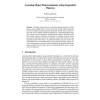Free Online Productivity Tools
i2Speak
i2Symbol
i2OCR
iTex2Img
iWeb2Print
iWeb2Shot
i2Type
iPdf2Split
iPdf2Merge
i2Bopomofo
i2Arabic
i2Style
i2Image
i2PDF
iLatex2Rtf
Sci2ools
AUSAI
2008
Springer
2008
Springer
Learning Object Representations Using Sequential Patterns
This paper explores the use of alternating sequential patterns of local features and saccading actions to learn robust and compact object representations. The temporal encoding represents the spatial relations between local features. We view the problem of object recognition as a sequential prediction task. Our method uses a Discriminative Variable Memory Markov (DVMM) model that precisely captures underlying characteristics of multiple statistical sources that generate sequential patterns in a stochastic manner. By pruning out long sequential patterns when there is no further information gain over shorter and discriminative ones, the DVMM model is able to represent multiple objects succinctly. Experimental results show that the DVMM model performs significantly better compared to various other supervised learning algorithms that use a bagof-features approach.
Artificial Intelligence | AUSAI 2008 | Local Features | Sequential Patterns | Sequential Prediction Task |
Related Content
| Added | 12 Oct 2010 |
| Updated | 12 Oct 2010 |
| Type | Conference |
| Year | 2008 |
| Where | AUSAI |
| Authors | Nobuyuki Morioka |
Comments (0)

